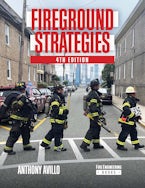Foreword Acknowledgments Introduction
1. Incident Command I: Strategic Considerations of Size-Up
COAL WAS WEALTH Process
2. Incident Command II: Arrival Reports and Resource Requirements
The Arrival and Initial Progress Reports
C-BAR
Managing the Crowds: Freelance Prevention
Support Resources
3. Incident Command III: Fireground Organization, Ongoing Communications,
and Post-Control Activities
Command Limitations: Managing the Unseen Area
Exterior versus Interior Size-Up: A Matter of Perception
Expanding the Command Structure: Decentralization
Postfire Control Activities
Post-Termination Activities
4. Strategic Considerations of Heat Transfer
The Stages of Fire
Effects of the Modern Fire Environment on Fire Behavior
Mechanisms of Heat Transfer
Case Study: 2-4 Potter Place Fire
Predicting and Preventing Flashover
5. Strategic Considerations of Building Construction
Buildings that Change the Rules of the Game
Class 1: Fire-Resistive Construction
Class 2: Noncombustible Construction
Class 3: Ordinary Construction
Class 4: Heavy Timber Construction
Class 5: Wood Frame Construction
6. Strategic Decision Making
Questions for Strategic Direction
Basic Classifications of Firefighting Strategy
Case Study: Rapido Taxi Fire
Changing Strategy
Case Study: Kennedy Boulevard Multiple Dwelling
Managing the Multiple Strategy Fire
7. Private Dwelling Fires
Firefighting Concerns in Private Dwellings
Case Study: Fifth Alarm on Palisade Avenue
Basic Structural Firefighting Procedures: The Five CRAVE Factors
8. Multiple Dwellings
Old-Law Multiple Dwellings
New-Law Multiple Dwellings
Firefighting Concerns in Old- and New-Law Multiple Dwellings
Operational Summary for Multiple Dwellings
Fire-Resistive Multiple Dwellings
Engineered Multiple Dwellings
Life Hazard Concerns in All Multiple Dwellings
9. High-Rise Operations
Observations and Suggestions
High-Rise Construction and Characteristics
Command and Control Operations
The Command Kit: Operational Control Aid
Firefighting Concerns in High-Rise Structures
Life Safety Concerns
Basic Firefighting Procedures: CRAVE
10. Attached Structures
Firefighting Concerns
Life Hazard Concerns
Accountability and Decentralization
Case Study: The Roc Harbor Townhouse Complex Fires
Basic Firefighting Procedures: CRAVE
11. Small Commercial Occupancies: Mixed-Use Occupancies, Taxpayers, and Strip Malls
Mixed-Use Occupancies and Taxpayers
Firefighting Concerns in Taxpayers and Mixed-Use Occupancies
Life Hazard Concerns in Mixed-Use and Taxpayer Occupancies
Basic Firefighting Procedures for Taxpayers and Mixed-Use Occupancies
Conclusion Regarding Taxpayers and Mixed-Use Occupancies
Strip Malls
Basic Firefighting Procedures for Strip Malls
12. Large Commercial and Storage Occupancies
Firefighting Concerns in Commercial Occupancies
Life Hazard Concerns in Commercial Occupancies
Basic Firefighting Procedures
Storage Occupancies
CRAVE for storage occupancies
United States Postal Service Property Fires
13. Strategic Considerations for Vacant, Repurposed, and Renovated Structures
Vacant Building Concerns
Alerting Our Own
Case Study: Vacant Funeral Home Fire
Basic Firefighting Procedures: Vacant Structures
Renovated and Repurposed Building Concerns
Basic Firefighting Strategies: Structures under Repurposing and Renovation
14. Limited Intervention Incidents
Hazardous Materials Incidents
Basic Firefighting Procedures
Additional Limited, Defensive, or Non-Intervention Incidents
Active Shooter Incidents—Command Considerations
Civil Unrest Conditions—Command Considerations
Lithium-Ion Incidents—Command and Operational Considerations
15. Fostering a Culture of Safety
Establishing Safety Values
Operating with Tactical Worksheets and Command Boards
Span of Control
Risk Management
Highway and Roadway Safety—Command Considerations
The Rapid Intervention Team
Command Considerations of RIT Activation—Reacting to the Mayday
Emergency Fireground Communication
Building Search Considerations
Thermal Imaging Considerations
16. Conclusion: Final Thoughts
Index About the Author

